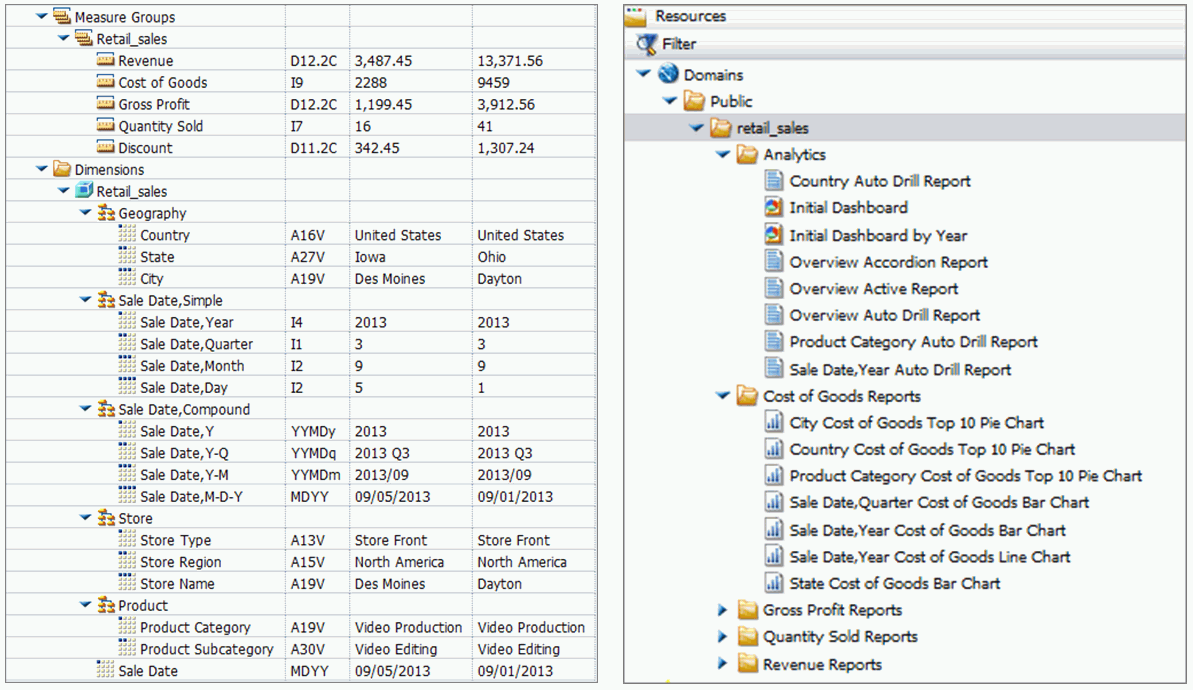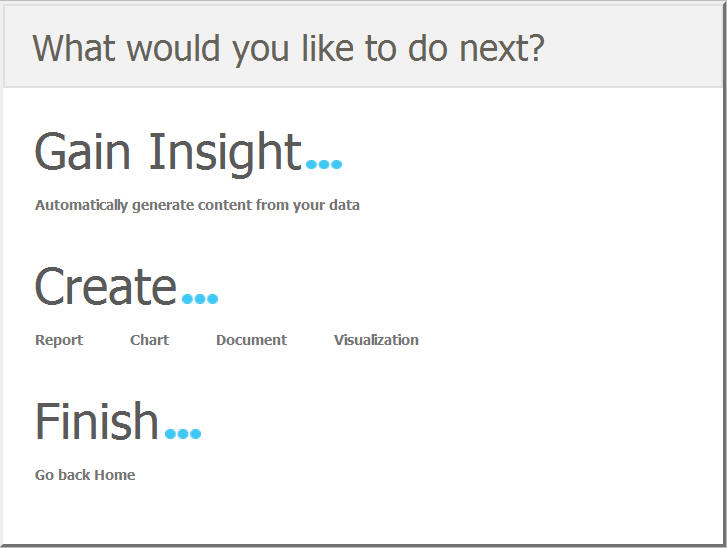Generating Sample Content Overview
|
How to: |
In WebFOCUS you can automatically generate a suite of analytic content based on uploaded Excel workbooks, CSV files, or existing single-segment Master Files in your repository, using the Sample Content feature. This feature populates your directory with sample charts, reports, and dashboards. Additionally, the suite contains charts and reports that provide quick and easy navigation through the levels of each available hierarchy. You can view, edit, or delete this content. You can also use this content as a starting point to create new dashboards, or save it in your Mobile Favorites node, and interact with it on your portable devices.
The Sample Content feature is useful to the novice user, because it introduces all major analytic content types in the InfoAssist toolset. Depending on the structure of your source worksheet or synonym, it automatically creates the following items:
- Active dashboards:
- Initial Dashboard
- Initial Dashboard by Year
Note: This item is only generated if your source dataset includes an eligible date, which contains data for minimum three unique months.
- Reports:
- Auto-drill report starting at the top of each identified hierarchy
- Overview accordion report
- Overview active report
- Charts:
- Pie chart
- Bar chart
- Line chart
Note: Line charts are only created if your source dataset includes an eligible date, which contains data for minimum three unique months.
The dashboards, auto-drill reports, overview accordion report, and overview active report are stored in the Analytics folder. All other items are placed in the folders that are named after the measures for which they are created. The content may vary depending on the structure and size of your synonym.
To see the most complete suite of analytical content, it is recommended that you use a data source that contains at least four measures, six dimensions, and data for a minimum of three unique months. Additionally, a record count called Trans appears in the sample content, if there are not sufficient measures available for analysis.
Note: Virtual fields, such as COMPUTE and DEFINE, are not eligible for selection as dimensions or measures in the generated content.
The following image shows an example of a synonym and the suite of sample content generated from this synonym and displayed in the Resources tree.

Note: If you generate sample content more than once from the same source worksheet or synonym in the same location, the Sample Content feature creates a new folder with an underscore and number appended to the title. For example, if a retail_sample folder already exists in a domain or folder, a new folder with the new set of content is created and titled retail_sample_1. The number is incremented each time you repeat this action.
You can generate sample content from one of the following ways:
- By navigating to the Sample Content option from the WebFOCUS Home Page or Legacy Home Page, which leverages existing data.
- By uploading an Excel spreadsheet or CSV file and selecting the Gain Insight option at the end of the upload procedure.
Procedure: How to Generate Sample Content from the WebFOCUS Home Page
- On the Home Page, in the actions bar, click Sample Content
 .
.The Sample Content dialog box opens.
Note: Only single-segment Master Files and folders containing these files are displayed for selection.
- Locate a single-segment Master File that you want to
use for generating sample content and click Open.
The new folder with the same name as your Master File appears in your chosen directory. It contains sample charts, reports, and dashboards.
Procedure: How to Generate Sample Content From the Legacy Home Page
- On the Legacy Home Page, in the Resources tree, right-click a
domain or folder, point to New, and then
click Sample Content.
The Open dialog box opens.
Note: Only single-segment Master Files are displayed for selection.
- Locate a single-segment Master File that you want to
use for generating sample content and click Open.
The new folder with the same name as your Master File appears in your chosen directory. It contains sample charts, reports, and dashboards.
Procedure: How to Generate Sample Content From the Upload Wizard
- Upload a spreadsheet,
as described in Uploading
and Appending Spreadsheets.
After the Upload procedure is complete, a selection screen opens, as shown in the following image.

Note: Generating sample content on Master Files uploaded to a temporary folder, such as FOCCACHE, may produce unexpected results.
- Click Automatically generate content from
your data.
The sample content is generated in the same folder that you selected for your upload.
| WebFOCUS | |
|
Feedback |